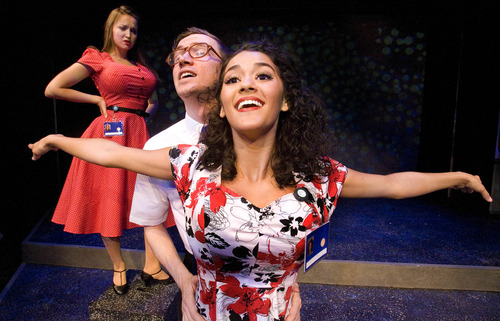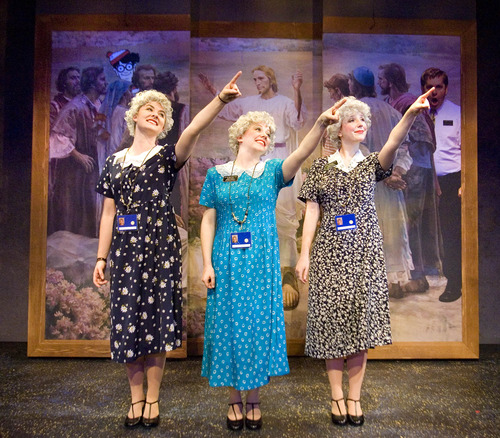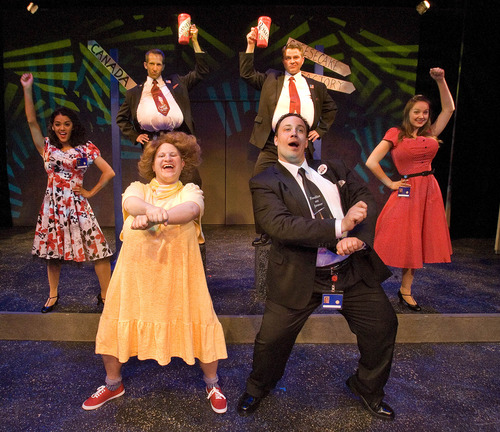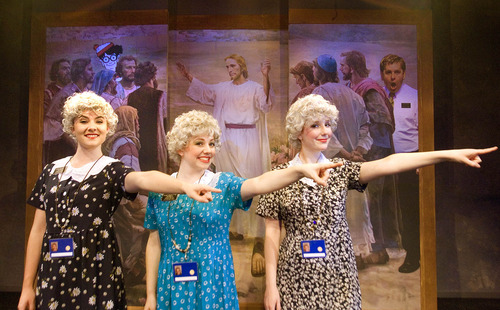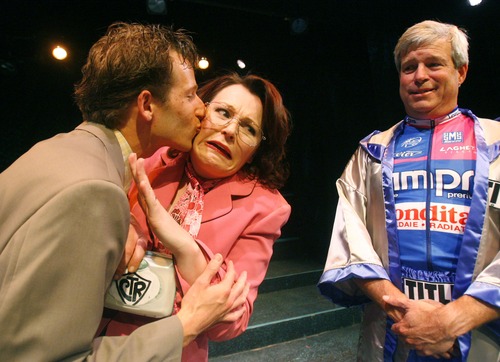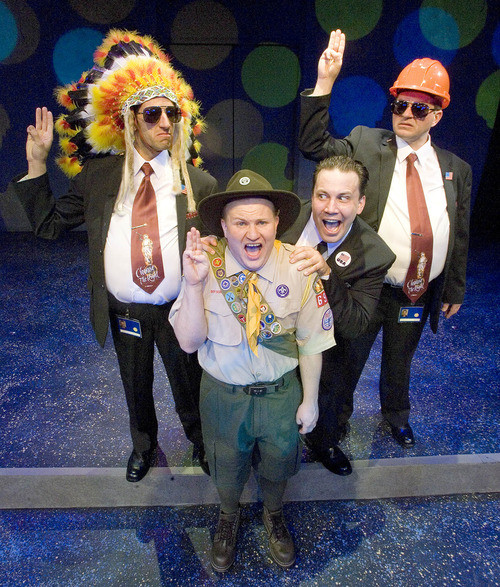This is an archived article that was published on sltrib.com in 2013, and information in the article may be outdated. It is provided only for personal research purposes and may not be reprinted.
Becki Mecham's mind reels from all the memories collected during 15 years of playing Mother Elthora in "Saturday's Voyeur." Many of them trace back to the towering beehive wig that was the glory of her character.
"I made my own little bumblebees to decorate it. It was a labor of love that just got bigger and bigger," said Mecham, a longtime Utah schoolteacher who retired from the role in 1993.
When the play first opened inside Elliot Hall at Salt Lake City's First Unitarian Church in 1978, it was by invitation only, Mecham remembers. It soon grew so popular she could no longer hide her growing local fame from her devout LDS family.
"I told them I was doing concessions," Mecham said. "I never wanted to hurt my family's feelings."
Feelings may have been hurt from afar. Mostly, though, the satiric take on the 1973 Mormon-themed musical "Saturday's Warrior" had local audiences rolling in the aisles.
This month the homegrown stage satire, the brainchild of Utah natives Nancy Borgenicht and the late Michael Buttars, will celebrate its 35th anniversary of lampooning local culture. The 2013 version plays at Salt Lake Acting Company June 26-Sept. 1. Much like the beehive wig that crowned Mecham's local fame years ago, the production has only grown larger with time.
The theater event of Salt Lake City's summer season has become such a fixture that Borgenicht and Allen Nevins, who joined her as co-writer in 1992, admit they sometimes struggle to maintain the play's original rebel spirit.
"You can only have so many firsts," Nevins said. "As Salt Lake City matures, the firsts are sometimes harder to come by."
But not original material. From its first productions poking fun at LDS family life, to Rep. Enid Greene Waldholtz's infamous news-conference meltdown, to the 2002 Olympics, to Utah Eagle Forum leader Gayle Ruzicka and beyond, "Saturday's Voyeur" has been the default gauge of cultural and political distance between the state's Republican Mormon and liberal non-Mormon contingencies. Borgenicht and Nevins admit their play harnesses tensions between the two.
Still, they prefer the dividing line be drawn between those who can laugh at themselves, or appreciate a good laugh, and those who can't.
—
"Another temple in Utah"• The show had its roots in the living room of the Borgenicht home, where a young Nancy grew up Jewish in predominantly Mormon Salt Lake City. Her father, a labor union lawyer, and mother, an actress, performed vaudeville-style numbers that often played on words and puns of local culture. Once perfected, Borgenicht said her parents often performed them at the local synagogue, or for her father's lawyerly colleagues as "Temple and Bar Follies."
"There's another temple in Utah, my mother was always writing," Borgenicht said.
Flash forward to 1977, with Douglas Stewart and Lex de Azevedo's "Saturday's Warrior" at the height of its popularity, plus ever more non-Mormons moving into Salt Lake City. Borgenicht said the whining from non-Mormons about how hard it was to live in Salt Lake City, let alone Utah, was loud enough for anyone to hear. But rather than let her imagination run wild, the first-ever production of "Saturday's Voyeur" was based on, of all things, a careful study of Mormon and non-Mormon focus groups.
"It came out of their own writings and firsthand experiences," Borgenicht said.
The first production at First Unitarian Church was billed as a celebration of the Days of '74, Borgenicht remembers. It featured a playbill photo of a Salt Lake Acting Company member with his hand on her breast in front of the Salt Lake City LDS Temple.
"Right after the first production [then-SLAC artistic director] Ed Gryska said, 'We're doing this again,' " Borgenicht said.
—
Enter the co-writer • Nevins, a New Jersey transplant to Salt Lake City in 1969, had acted in several theater productions as part of the then-Human Ensemble Theatre, based in Arrow Press Square during the 1970s. Oddly, he wasn't smitten during his first exposure to "Saturday's Voyeur" in 1982.
"I never saw myself as oppressed [living in Salt Lake City], so in many ways it didn't work for me," he said.
What grabbed him instead was the production's ripe potential for punch lines and comic scenes. So when he was hired as SLAC's literary manager in 1989, in an office shared with Borgenicht, the two launched a partnership that would survive numerous tests before it could triumph.
Rather than the boon to the theater company's bottom line that it is today, according to the duo, the SLAC administration at the time instead saw "Saturday's Voyeur" as an offensive liability to its fundraising efforts. Nevins and Borgenicht said they were dismissed from the company the same day in 1990. They took "Voyeur" with them.
During the early 1990s, the musical satire continued to play to packed houses on Green Street. Meanwhile, SLAC's financial situation had deteriorated near the point of bankruptcy. In 1993, Borgenicht and Nevins — and their company Saturday's Voyeur Inc. — were rehired by SLAC's board to manage the theater company. "Saturday's Voyeur" was becoming an institution of Utah theater no one would deny.
But it was also time for a change.
Three years later, with Waldholtz's political troubles making national headlines at the same time as Andrew Lloyd Webber's "Phantom of the Opera" was rolling into Salt Lake City, Borgenicht and Nevins decided to turn the musical into a chameleon reflecting the colors of the then-current political climate, rather then dwell endlessly on Mormon ways. "Phatman of the Opera," still considered one of the finest editions of the "Saturday's Voyeur" franchise, was born.
"We were scared," Borgenicht said. "We didn't know if the audience would go with it. But when it worked, Allen said it proved we could take the show almost wherever we wanted. He gets total credit for that."
—
Mitt, the sequel • This year's 35th-anniversary version takes up where last year's version, "The Mormon Moment," left off.
Nevins said the elation surrounding Mitt Romney's presidential bid, followed by November 2012 letdown after the re-election of Barack Obama, proved too tempting to leave alone. Part of the attraction was its setting inside the Church Office Building of The Church of Jesus Christ of Latter-day Saints, with its elevator doors, corridors and rumored underground tunnel passageways — an apt metaphor for the topsy-turvy world of cultural life in Utah's capital city.
Fans of last year's show will recognize the milieu, but there's plenty of current political grist for chewing, including references to the troubled political career of Attorney General John Swallow, who's taken to bribing the sisters in the church office with doughnuts.
Borgenicht said picking up that thread once more helps "Saturday's Voyeur" return to its roots.
"The Church Office Building setting allows for that," she said. "We knew last year that if [Romney] wins, it takes the show in a different direction. If he lost, we're still in the same place."
After all these years, after which she first saw the comic tension of Utah life set onstage, Borgenicht said she looks forward to many more.
"When I'm 80 years old, I'll look forward to the 50th year," she said.
'Saturday's Voyeur' 35th Year Anniversary Edition
When • June 26-Sept. 1. Wednesday-Saturday, 7:30 p.m.; Sundays, 1 and 6 p.m.
Where • Salt Lake Acting Company, 168 W. 500 North, Salt Lake City
Tickets • $39-$55. Call 801-363-7522 or visit http://www.saltlakeactingcompany.org for more information.


